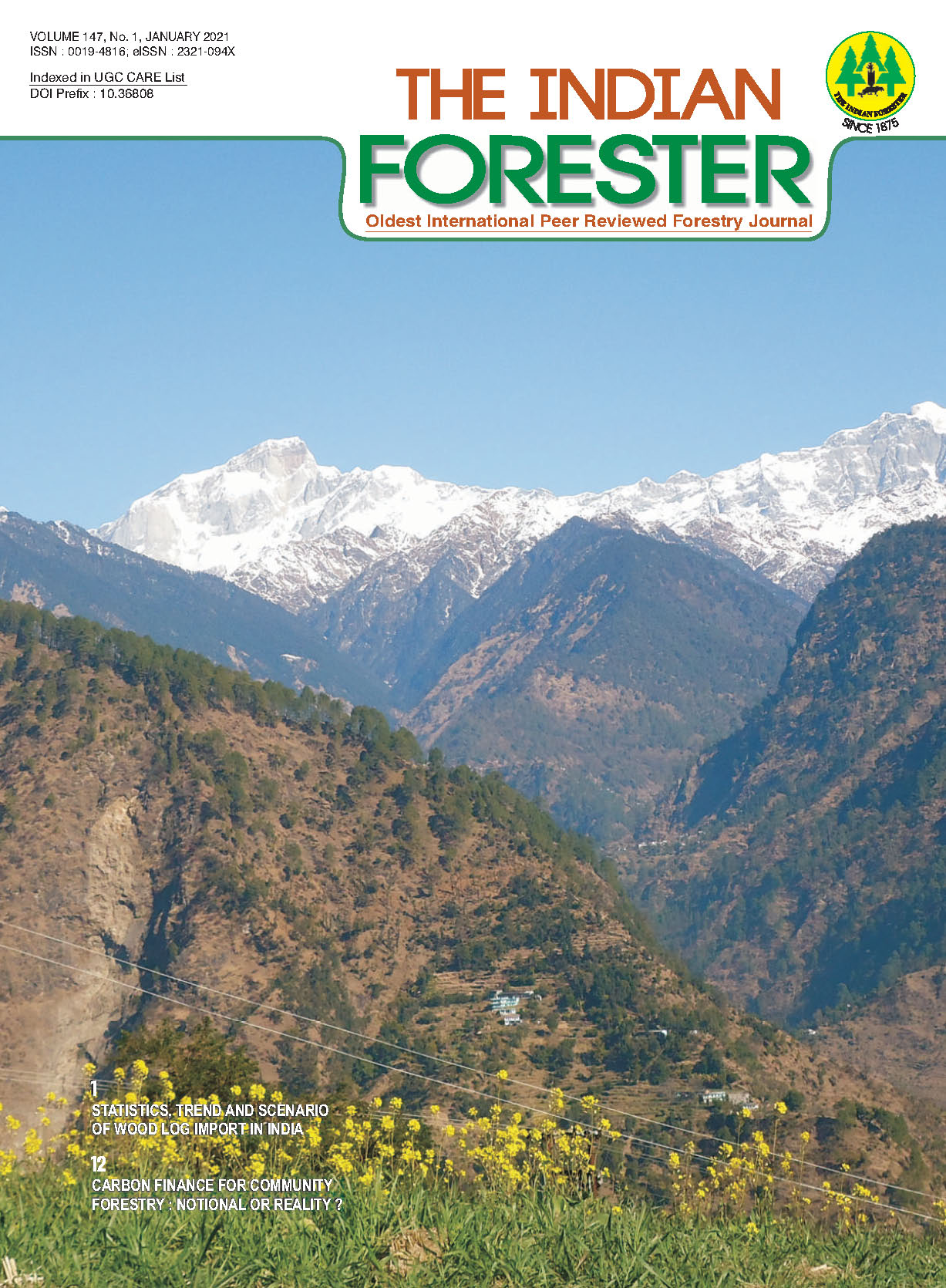Statistics, Trend and Scenario of Wood log Import in India
DOI:
https://doi.org/10.36808/if/2021/v147i1/154473Keywords:
Wood Logs, Import, Ports of India, Forcasting, ARIMA Model.Abstract
Import of wood logs to India from top ten countries in terms of volume were studied and analysed in this paper. The study was done in terms of value and quantities based on twenty-five years of import statistics from Year 1991 to 2016. The trend of wood import from these countries was studied. Top ten ports in India receiving such imports were also analyzed in The import of wood log terms of value and quantities. From the import statistics, it was observed that Malaysia, New Zealand and Myanmar were top three exporters to has increased b y more India during 2011 to 2016 with 9503.72 cum (31.14%), 7797.09 cum (25.55%) and 4394.99 cum (14.40%) respectively. However, it was seen that till 1996 the major import of wood logs of about 1837.45 cum (51.23%) was received from Malaysia. The major import of wood logs during 2011-16 was received at Kandla port of about 14952.61 cum (49%) followed by adjoining Mundra port with 5248.14 cum (17.20%), Tuticorin maximum with 3498.24 cum (11.46%) and Kolkata ports with 2502.49 cum (8.20%). The major import of wood logs is being received at Kandla port since year 2000. Further in the study, with the help of Auto Regressive Integrated Moving Average (ARIMA) model, forecasting of wood log mostly import was made for 5 years, from 2016-2017 to 2020-2021.References
Anon. (2012). Wikipedia encyclopaedia, Economy India. https://en.wikipedia.org/ wiki/Economy_of_India#cite_note IMF_GDP-1.
Anon. (2016a). India: wood sector market study-2016. American Hardwood Export Council, Washington, Woodzon.
Anon.(2016b). Data import of wood logs collected from Directorate General, Commercial Intelligence and Statistics (DGCIS), Kolkata, Govt. of India.
Bartosh G. (2007). Update: Market Research India. Market report as published Fall by Forestry Innovation Investment.
Bhojvaid P.P., Singh M.P, Jawaid Ashraf and Reddy S.R. (2013). Transition to sustainable forest management and rehabilitation in Asia pecific region. Country Report - India. Forest Survey of India, Dehradun.
Bhojvaid P.P., Singh M.P., Reddy S.R. and Ashraf J. (2016). Forest transition curve of India and related policies, acts and other major factors, Tropical Ecology 57(2): 133-141.
Box G. and Jenkins G. (1970). Time-Series Analysis: Forecasting and Control. Holden-Day Press, San Francisco, CA, 784 p.
FAO (2004). What does it take? The role of incentives in forest plantation development in Asia and Pacific. Asia Pacific Forestry Commission, Food and Agriculture Organisation (FAO), Bangkok.
Forest Sector Report India (2010). Indian Council of Forestry Research and Education, Dehradun (Ministry of Environment and Forests), Govt. of India.
Forest Trends (2006). China and the Global Market for Forest Products- Transforming Trade to Benefit Forest and Livelihoods, Forest Trends, Washington D.C.
FSI (1995). State of Forest Report. Forest Survey of India, Dehradun.
FSI (2008). State of Forest Report. Forest Survey of India, Dehradun.
Ghosh M. and Sinha B. (2016). Impact of forest policies on timber production in India: a review. A United Nations Sustainable Development Journal https://doi.org/10.1111/1477-8947.12094.
Joshi A.K., Pant P., Kumar P., Giriraj A. and Joshi P.K. (2010). National Forest Policy in India: Critique of Targets and Implementation. Small scale Forestry DOI 10.1007/s11842 010-9133-z.
India forestry outlook study. (2009). ASIA-PACIFIC Forestry Sector Outlook Study II, Working Paper No. APFSOS II/WP/2009/06, Ministry of Environment and Forests, New Delhi.
ITTO (2004), Review of the Indian timber market (by Sri Maharaj Muthoo) PPR 68/04(M), International Tropical Timber Organisation.
ITTO (2008). Annual review and assessment of the world timber situation-2007, International Tropical Timber Organisation, Yokohama, Japan.
Manoharan T.R. (2011), Supply Determinates of Timber Trade in India, WWF-India, Supported by Planning commission, Govt. of India.planningcommission.nic.in/reports/sereport/ser/ser_timber300511.pdf
Midgley S., P. Lal, Bhojvaid P.P. and Brown A. (2007). A Strategy for Developing Market Opportunities for Australian Forest Products in India. Report to the Forest Industries Branch, Department of Agriculture, Fisheries and Forestry, Brisbane, Australia.
Montiel P. 2016. Analysis of India as a Market Area for Sawnwood. M.Sc. Thesis in Forest Sciences and Business, Department of Forest Sciences, University of Helsinki, 144 p.
NCA (1972). Report of the National Commission on Agriculture. Part IX Forestry, Ministry of Agriculture and Irrigation, New Delhi.
Pandey C.N. and Rangaraju T.S. (2008). India's industrial wood balance. International Forestry Review 10(2): 173-189.
Shrivastava Soujanya and Saxena Ajay Kumar (2017). Wood is Good: But, is India doing enough to meet its present and future needs? Centre for Science and Environment, New Delhi.
Singh R.V. (1991). Timber demand in India: Prospectus for future supply and substitution In: CSE-The Price of Forests, Centre for Science and Environment, New Delhi.
Sood D. (2014). GAIN Report: Wood and Wood Products in 2014. Report Number: IN4049, New Delhi. Food and Agriculture Organization of the United Nations 2015. FAO Yearbook of Forest Products 2013. FAO, Rome.
Yadav M. and Basera K. (2013). Status of forest products production and trade. Working Paper Series (2013/1). Centre for Sustainable Forest Management and Forest Certification, Indian Institute of Forest Management, Bhopal, India. Available at:http://project.aabsys.com/iifm/demo/sites/default/files/working/IIFMWP-13-10- 01.pdf.
Downloads
Downloads
Published
How to Cite
Issue
Section
License
Unless otherwise stated, copyright or similar rights in all materials presented on the site, including graphical images, are owned by Indian Forester.





